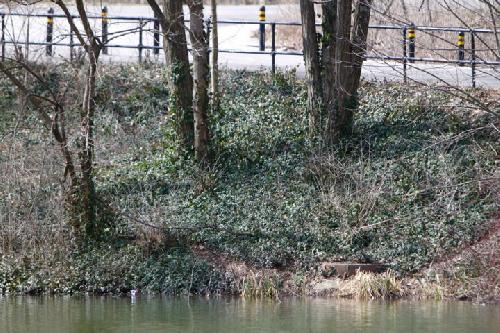Natural solutions are all the rage to people who believe in a 20th century "balance of nature" hypothesis. Scientists know better, it is obvious that there is no ecological balance, no environmental harmony, and never has been, the winners are in nature are instead species who got somewhere first or were better suited to an area and outlasted others and so seemed to be a balanced fit.
Flawed balance of nature thinking is why so many environmental ecologists once believed introducing a new species to an area would bring balance to an old one - which has rarely happened - and modern ones have to clean that up. At Bender Mountain Preserve and other natural wooded areas in southwestern Ohio, University of Cincinnati Biologist Denis Conover, and Tim Sisson, president of the Western Wildlife Corridor, would like to do just that.
Recent work detailed in journal Ecological Restoration focused on Wintercreeper, English Ivy, and Lesser Periwinkle, three of the imported species that have spread from residential and commercial landscape beds into Southern Ohio wooded areas. Those are evergreen ground covers that spread quickly in wooded natural areas. English ivy and wintercreeper can climb, flower and produce berries that are eaten by birds, who later disperse the seeds elsewhere through their droppings.
The hardy and aggressive nature of the evergreen invasive species allows for easy domination over native plants that go dormant over the winter. But according to the researchers, this evergreen feature is also what makes them easy to kill and control during winter months while not harming nearby dormant native plants.
How? By using what environmentalists hate: Foliar Spraying.

Yet they realize the only way to bring back original species from the brink of destruction is to use the science that works, not the ideology that has become prized by hundred million dollar environmental groups with lobbyists, lawyers and friends in the New York Times editorial staff.
"SPRAYING" IT FORWARD
"We have found that the spread of all three of these species can be slowed by spraying their leaves with specific herbicides during late winter when native plants are dormant," says Conover. "By minimizing the herbicide exposure to native plants we are now seeing a positive regrowth of valuable native wildflowers, trees and shrubs."
Using varying concentrations of herbicides mixed with added surfactants, the researchers sprayed the invasive ground covers and used a stump-cut method on more mature climbing vines in both Avon Woods Nature Preserve and Bender Mountain Nature Preserve in Southwestern Ohio.
A few weeks after applying the herbicide treatments in late winter, much of the wintercreeper, English ivy and lesser periwinkle had died. Remarkably in the spring, the researchers observed a surprising number of native plants growing once again in the sprayed areas, some of which included: Virginia creeper, Solomon's seal, cutleaf toothwort, wild black cherry, Ohio buckeye, sugar maple and mayapples, just to name a few.
Conover hopes that instead of using non-native invasive landscape plants like Chinese silvergrass, homeowners and horticulturists will use one of this area's beautiful native tall grasses such as prairie dropseed, little bluestem, big bluestem, switch grass or Indian grass because, "restoring the flora to its native species will enhance the biodiversity of native plants and the native animals, including butterflies that depend on them."
PUBLIC ENEMY NUMBER ONE
Conover and Sisson report some success against another Asian import seen all over the Midwest. Introduced to North America by Botanical Gardens in the 1890s, Amur honeysuckle -- referred to by Conover as public enemy number one -- has formed dense thickets in the local forest sub-canopies, choking out native species everywhere it grows.
In their upcoming second Ecological Restoration publication titled "Resurgence of Native Plants After Removal of Amur honeysuckle from Bender Mountain Preserve," Conover and Sisson reveal the lengths to which honeysuckle alters habitats by decreasing light availability and depleting soil moisture and nutrients, as well as by possibly releasing toxic chemicals that prevent other plant species from growing in the vicinity.
While focusing this research on the removal of Amur honeysuckle growing in the Bender Mountain Nature Preserve, a successful multi-task method used to kill honeysuckle was based on research conducted in the 1990s by Conover and Geiger, at the Mt. St. John Nature Preserve in Greene County, published in Restoration and Management Notes (1993) and the Ohio Woodland Journal (1996), which involved:
- Fall foliar spraying with specific concentrations of herbicide
- Cutting of the plants and stump treatment with herbicide
- Physically removing the plants
Because Amur honeysuckle leafs out earlier and holds its leaves longer than native trees and shrubs, Conover and Geiger suggested foliar spraying on warm days in the fall after the native shrubs and trees have lost their leaves.
Not surprisingly, Amur honeysuckle successfully absorbed the herbicide through its leaves and died leaving the surrounding dormant native plants to grow in the spring.
In the wake of this study, Conover also includes a vascular plant survey conducted in the past couple of years that has identified over 387 vascular plant species now growing in Bender Mountain Nature Preserve. Over 90 percent are native to Hamilton County, Ohio, and the list of species includes two horsetails, four ferns, 70 woody plants (shrubs, trees and vines), four rushes, 15 sedges, 35 grasses and 257 wildflowers. The list will be published by the Ohio Biological Survey in an upcoming article by Conover and Sisson.
While there has been great success in restoring native species into the Ohio River Valley Western Wildlife Corridor, the researchers hope their efforts inspire a national conversation about the benefits of incorporating more native plants into residential and commercial landscape beds, especially those near natural wooded areas.




Comments